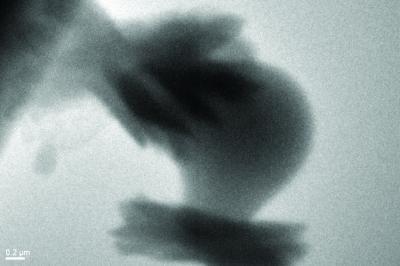Morphing Minerals
The videos revealed that mineral growth took many pathways. Some crystals formed through a two-step process. For example, droplet-like particles of ACC formed, then crystals of aragonite or vaterite appeared on the surface of the droplets. As the new crystals formed, they consumed the calcium carbonate within the drop on which they nucleated.
Other crystals formed directly from the solution, appearing by themselves far away from any ACC particles. Multiple forms often nucleated in a single experiment -- at least one calcite crystal formed on top of an aragonite crystal while vaterite crystals grew nearby.
What the team didn't see in and among the many options, however, was calcite forming from ACC even though researchers widely expect it to happen. Whether that means it never does, De Yoreo can't say for certain. But after looking at hundreds of nucleation events, he said it is a very unlikely event.
"This is the first time we have directly visualized the formation process," said De Yoreo. "We observed many pathways happening simultaneously. And they happened randomly. We were never able to predict what was going to come up next. In order to control the process, we'd need to introduce some kind of template that can direct which crystal forms and where."
In future work, De Yoreo and colleagues plan to investigate how living organisms control the nucleation process to build their shells and pearls. Biological organisms keep a store of mineral components in their cells and have evolved ways to make nucleation happen when and where needed. The team is curious to know how they use cellular molecules to achieve this control.

Diamond-shaped crystals of calcite form directly from solution. A round particle that could be either amorphous calcium carbonate or vaterite forms nearby.
(Photo Credit: Nielsen et al. 2014/Science)

Amorphous calcium carbonate (round particle) forms and grows in size, then transforms into aragonite, which looks like bundles of wheat. The aragonite consumes almost the whole particle of amorphous calcium carbonate.
(Photo Credit: Nielsen et al. 2014/Science)

An aragonite crystal -- with its characteristic "sheaf of wheat" look -- consumed a particle of amorphous calcium carbonate as it formed.
(Photo Credit: Nielsen et al. 2014/Science)